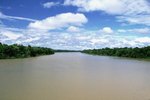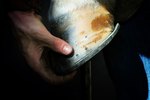Some diseases that affect the African dwarf frog present immediately with various symptoms, while others work over your frog undercover. The causes for African dwarf frog diseases range from the obvious, such as an open wound that invites bacteria inside, to the unknown. Medications can treat some African dwarf frog ailments, others are fatal.
Dropsy
If your African Dwarf frog is packing on the pounds -- or in his case, grams -- his weight gain might be completely normal, especially if you just bought him or started feeding him a more nutritious diet. A stomach that rapidly bloats is a bad sign. He likely has a condition known as dropsy, which causes stomach bloating and ultimately death. The disease has no known causes, although a few ideas, from bacteria to improper diet, have been thrown around. Unfortunately, it's highly unlikely your pal will bounce back from dropsy -- it's an extremely deadly disease. Do not rely on home treatments for dropsy. Always consult a vet.
Fungal Infections
Lots of harmful fungi affect African dwarf frogs. The signs of a fungal infection typically include small white cottony patches all over your frog's skin, or one white spot that grows larger, a lack of appetite and wrinkly and poor-looking skin that might come off in tatters when he sheds. Your amphibian might also try to seemingly scratch the disease off himself by running into plants and decorations. The white patches are by far the most common symptoms. Antifungal medications can kick many types of fungal infections to the curb; however, a particularly resilient fungal disease called chytrid is a major problem for all frogs; if one of your African dwarfs has it, your others will quickly have it too -- African dwarfs or other variants.
Bacterial Infections
Unlike fungal infections, which usually cause noticeable symptoms, bacterial infections are trickier to spot. Your dwarf frog will likely stop eating regularly and may not eat at all as the infection progresses. He'll probably keep still and seem lethargic, and he may have cloudy eyes. If you look close, you may see his skin seem slightly reddened.
Water Conditions
Any time you think your dwarf frog might have a disease, check your water conditions with a water test kit. Ammonia, nitrite and nitrate should read 0, 0 and 40 parts per million, respectively. Poor water conditions can mimic some symptoms seen in diseases as well as exacerbate any conditions your frog has. Change 20 percent of your water daily to bring those levels back within the healthy parameters, then follow up with a weekly 20 percent water change.
Treatment
If you have a vet that specializes in amphibians, make an appointment. Such vets aren't overly common. If you don't have such a vet near you, consult a regular vet. If that doesn't pan out, treat your frog's condition with over-the-counter medicine. General antibiotics and anti-fungal medications are your best bet, depending on what your frog has. Always quarantine your gray-green swimmer in a separate tank. Quarantining keeps your other frogs healthy and prevents medications from harming your other fish, snails or shrimp. Make sure all medications are frog-safe. If you ever find your frog on his back and unable to right himself, flip him over immediately. Dwarf frogs require air to live, so they have to swim to the surface occasionally.
References
Writer Bio
Located in Pittsburgh, Chris Miksen has been writing instructional articles on a wide range of topics for online publications since 2007. He currently owns and operates a vending business. Miksen has written a variety of technical and business articles throughout his writing career. He studied journalism at the Community College of Allegheny County.





